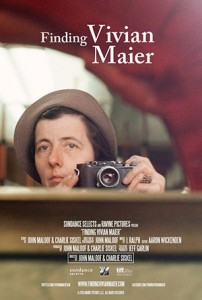Finding Vivian Maier
Posted on April 24, 2014 at 6:00 pm
 Vivian Maier was a Chicago-area nanny. Only the children in her care knew how much she loved taking pictures. After her death, the possessions she had in storage were auctioned off and a man named John Maloof bought some boxes of negatives, thinking he might finds some images for his research about a Chicago neighborhood. The quality of the photos surprised him. He put them online and the response was swift and passionate. Who was this photographer who captured these striking images? And why had no one ever heard of her?
Vivian Maier was a Chicago-area nanny. Only the children in her care knew how much she loved taking pictures. After her death, the possessions she had in storage were auctioned off and a man named John Maloof bought some boxes of negatives, thinking he might finds some images for his research about a Chicago neighborhood. The quality of the photos surprised him. He put them online and the response was swift and passionate. Who was this photographer who captured these striking images? And why had no one ever heard of her?
Maloof bought up the rest of Maier’s negatives and anything else she left behind. She was something of a hoarder, so there were piles of ephemera as well as rolls of undeveloped film. Maier’s passion for privacy came up against someone equally obsessive about uncovering her secrets as well as her photographs. As co-producer of the film, Maloof’s own motives do not get the scrutiny they otherwise might, but it is clear that he has something to gain from promoting her work, and that he is at least aware of the moral dilemma of creating such a public persona for such a private person after she no longer has a say. Though he is clear about his purpose: “My mission is to put Vivian in the history books.”
It is very rare in this country, where fame and braggadocio are considered virtues and we put people on magazine covers who are just famous for being famous, that gifted people are also private people. Those who decide to leave the limelight — Salinger, Garbo — are a source of great curiosity for us. What are they thinking? And then there are people like Maier and another Chicagoan, Henry Darger (also the subject of a documentary), and James Hampton, who are drawn more by compulsion as well as inspiration. If there is an intended audience, it is not of this world.
People who knew her, or thought they did, describe her: paradoxical, eccentric, private, loner. And there is the inevitable snobbery: “Why is a nanny taking all these photos?” But photographers recognize one of their own. Joel Mayerowitz, the film’s most engaging voice, says she had “an authentic eye and a real savvy about human nature and photography in the street.” She has human understanding, warmth, playfulness, at least in her photos. An employer said she has “an eye for the bizarre, the grotesque, the incongruous, the folly of humanity.”
Her camera of choice was a twin-lens Rolleiflex, a “great disguise camera…to generate a moment where two presences vibrate together.” Her subjects could look her in the eye while her camera was unobtrusively at her waist. She took up nannying so that she would not have to worry about shelter and she would have an excuse to be out and about. Her charges, now grown, remember her taking them all over, always with her camera, sometimes to rather odd places, like a stockyard.
Some of her secrets are revealed, including her efforts to hide her origins. Some are only indicated. And of course the photographs tell as much about Maier as they do about the people she captured.
As we look at them, though, we realize she captured much of us as well.
Parents should know that this movie includes discussions of abuse, an auto accident, and a sad death.
Family discussion: Which of Maier’s images is your favorite and why? Should her photos be made public after her death even though she kept them secret while she was alive?
If you like this, try: Martha & Ethel and Annie Leibovitz: Life Through a Lens
and the book Vivian Maier: Street Photographer
